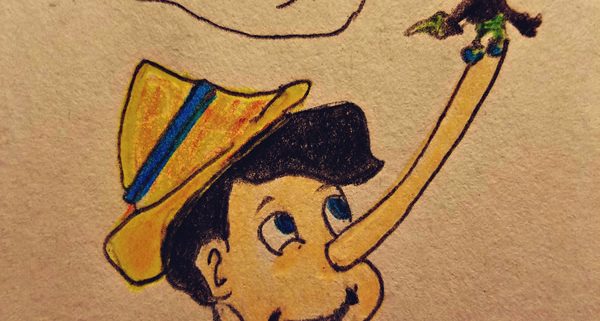Interrogation: The Reid Technique
The art of interrogation is exactly that … an art. It’s an elaborate song and dance routine that begins with the two participants squaring off, much like a pair or group of birds searching for a mate. Doesn’t make sense, you say? Well, lets compare the Blue Manakin to the investigators who’re hard at it trying to illicit a confession from a bad guy.
Step One
Blue Manakin – An alpha male initiates the ritual by first forming a team of birds to help him attract females.
Cops – The cop in charge picks other cops to serve as either good cop or bad cop, or to simply be present as witnesses.
Step Two
Blue Manakin – When an interested female comes along, the team begins flying around her, flapping their wings and making a buzzing noise. She likes this.
Cops – Try to make the suspect feel at ease with casual conversation, a little something to eat and/or drink, and perhaps even a cigarette. Bad guys like this.
Step Three
Blue Manakin – When he feels the time is right, the alpha bird commands his partners to stop the flapping and buzzing and other acrobatics. If the female liked what she saw, she’ll mate with the alpha male.
Cops – When he/she feels the time is right, he/she will stop the questioning and listen. If the suspect likes what he’s heard, he spills his guts.
Step Four
Blue Manakin – The alpha bird’s team is dismissed.
Cops – With confession in hand, the suspect is delivered to the county jail. Everyone moves on to the next case. If the cops did their jobs correctly, all will be well. If not, the case is dismissed.
Step Five
Blue Manakin – Alpha’s team members stand by, waiting for something to happen to alpha male so they can battle to take his place.
Cops – There’s more to do than any one investigator could accomplish in a lifetime. No one hurries to take his/her place.
During the interrogation ritual, investigators use a variety of methods to gain confessions. One such tactic is the Reid Technique. The Reid Technique is a nine-step method that is in three primary stages – Fact Analysis, The Investigative Interview, and The Interrogation.
Keep in mind that officers are permitted to lie during an interrogation. However, they are not allowed to offer leniency, a spot in a particular jail or prison, and they are not, at any time, to threaten a person for any reason.
The nine steps of the Reid Technique are:
1. The positive confrontation. The investigator tells the suspect she knows they’re guilty and has the evidence to back up the claim.
2. Theme development. The investigator then presents a moral reasoning (theme) for the offense. This could include, for example, placing the moral blame on someone else or circumstances beyond the control of the suspect. The investigator delivers the theme in a monologue fashion and in a definite manner that is sympathetic to the suspect. They’re trying to “win” his confidence.

3. Handling denials. The suspect is likely to ask permission to speak and this is usually to deny the accusations. The investigator should not allow the suspect to do
so (continue with the denials). Move on.
Suspects often interrupt an officer’s questioning to exclaim their innocence, guilty or not.
4. Overcoming objections. When attempts to deny are not successful, a guilty suspect sometimes finds a way to object to an officer’s accusations by offering reasons as to why they’ve claimed innocence – “I couldn’t have killed Sally Sue, because I loved her.” The savvy investigator should pretend to accept these objections as if they were the absolute truth. This is not the time to argue with the suspect. Instead, set aside the reasons for the denial for further development of the theme.
5. Procurement and retention of suspect’s attention. The investigator must always be sure the suspect is attentive and focusing on the theme and the officer’s words rather than the possible consequences for his actions (punishment). To do so, it’s best to close the physical distance between the detective and the suspect. Keep the suspect’s mind as far away from prison and jail as possible.
6. Handling the suspect’s passive mood. The investigator should maintain an understanding and sympathetic demeanor while encouraging the suspect to tell the truth.
7. Presenting an alternative question. The investigator should present two choices, with one being a better justification for the crime other than the truth – “I don’t think you’d do something like this on purpose, right? Why don’t you tell me exactly what happened so we can best know how to move forward. I want to help you do the right thing.”
8. Having the suspect orally relate various details of the offense. After the suspect accepts one side of the alternative (this is the “gotcha” moment because they’ve just admitted guilt), the detective should immediately acknowledge the admission of guilt and then have them describe what took place, in their own words. This is the time to LISTEN. A great investigator knows how and when to listen. LISTEN!!
9. Converting an oral confession to a written confession. The suspect writes his confession. Or, it’s transcribed and he signs it.













Great information and, as usual, given in a creative way that makes it memorable. Thanks again, Lee, for your outstanding posts.
Great info, Lee! I have a few questions: couldn’t offering leniency, a spot a particular jail or prison, etc., be considered lying? Or, are these the only lies that are not acceptable? And, finally, WHY is it unacceptable to lie about these things?